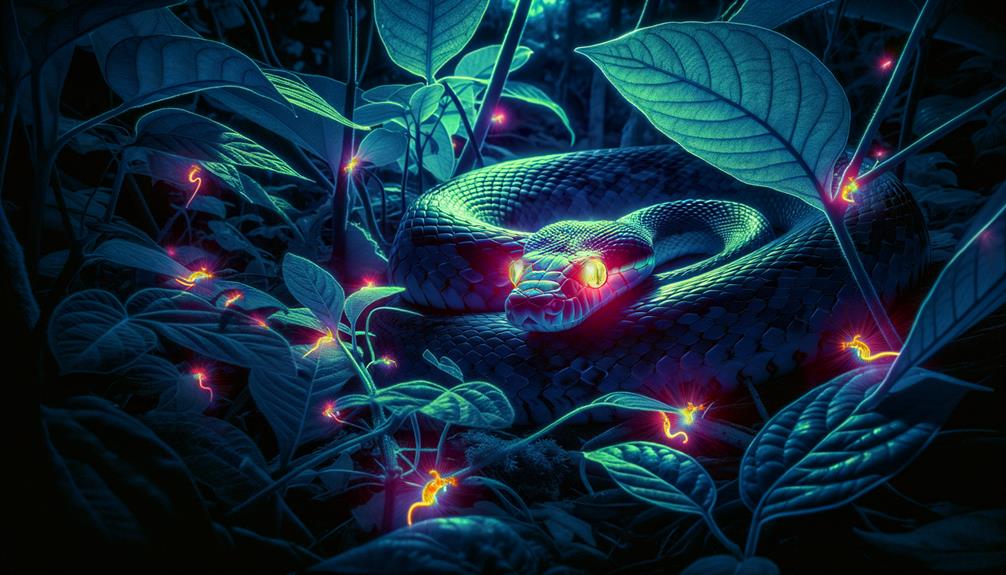I've always been fascinated by the extraordinary senses of certain reptiles. Snakes, for example, can detect low-frequency vibrations in the ground and have infrared-sensitive pits that allow them to sense heat from prey even in complete darkness. Many lizards and turtles have a broader range of color vision, which may include ultraviolet, helping them navigate and communicate. The Jacobson's organ in many reptiles enhances their sense of smell and taste, crucial for survival. Crocodilians have an advanced auditory system that allows them to pick up both airborne and underwater sounds. These remarkable adaptations give us a glimpse into the incredible sensory world of reptiles.
Key Takeaways
Pit vipers, boas, and pythons have specialized heat-sensing organs that detect infrared radiation from warm-blooded prey, giving them an edge in hunting.
Reptiles use their Jacobson's organ to convert tastes into smells, allowing them to better sense their environment and detect chemical cues.
Snakes can pick up on low-frequency vibrations in the ground through their skeleton and skin, helping them to detect potential threats or prey.
Some lizards have the ability to see in ultraviolet light, which improves their ability to detect prey and communicate with other members of their species.
Crocodilians have a unique ear structure that allows them to hear both airborne and underwater sounds, giving them a keen sense of awareness in their environment.
Vision
When it comes to vision, reptiles have developed some remarkable adaptations to thrive in diverse environments. Their sense of sight varies as much as the reptiles themselves. Many snakes, for example, don't rely on sharp vision but are highly sensitive to movement. Nocturnal species with slit-shaped pupils and smaller eyes navigate the dark with ease, while diurnal snakes sport round pupils, suited for daylight.
Lizards and turtles take colour vision to new heights. They can perceive a broader spectrum, possibly even ultraviolet light, which most snakes can't see. What's remarkable is that lizards can distinguish colours in moonlight, a feat few animals can match. Geckos, in particular, have colour vision that's 350 times more sensitive to low light than ours.
This advanced vision isn't just about seeing in different light conditions. It's also closely tied to a reptile's body temperature and ambient temperature. Blood vessels near their eyes help regulate body temperature, ensuring effective function. The yellow filters in their eyes absorb ultraviolet light, protecting their vision from the sun's harsh rays. These unique adaptations show that the freedom to move and hunt across different environments is deeply rooted in their extraordinary sense of sight.
Hearing

In exploring reptilian hearing, it's fascinating to see how these creatures use their relatively simple inner ear structures to detect low-frequency vibrations from their environment. Unlike mammals, reptiles don't rely on complex auditory mechanisms. Instead, they've adapted to sense vibrations through both the ground and air.
Snakes have developed a unique way to detect these vibrations. Without external ears, they sense ground vibrations through their skeleton and skin, allowing them to detect the approach of predators or prey with remarkable precision. This method of vibration detection is incredibly efficient, enabling them to survive and thrive in various environments.
Crocodilians have a more advanced auditory system. They possess an eardrum, middle ear, and inner ear, which grant them the ability to hear airborne vibrations and underwater sounds. This enhanced hearing aids in communication and hunting, making them formidable predators.
Lizards exhibit a diverse range of auditory capabilities. Some species can hear a broader spectrum of frequencies, tailored to their specific ecological niches. Primarily, reptilian hearing facilitates intraspecific communication, such as mating calls, rather than detailed environmental awareness. This remarkable adaptation highlights the evolutionary ingenuity of reptiles in using vibrations to navigate their world.
Smell and Taste

Reptiles have an extraordinary ability to perceive their environment through the intricate interplay of smell and taste, primarily facilitated by the highly specialized Jacobson's organ. This remarkable organ allows them to convert tastes into smells, providing a unique way to gather olfactory information. When a snake or lizard flicks its tongue, it captures particles in the air, which are then processed by the Jacobson's organ.
The combined sense of smell and taste gives reptiles a heightened awareness of their surroundings. This sensory integration enables them to locate prey, find mates, and detect nearby predators with remarkable accuracy. The Jacobson's organ is incredibly sensitive, capable of picking up even the faintest chemical cues that might go unnoticed by other animals. This essential sense is vital for their survival, as it allows them to navigate and respond to various stimuli in their environment efficiently.
Reptiles don't rely solely on vision or hearing. Instead, their olfactory and gustatory senses work together seamlessly, providing a multi-faceted perception of their world. This sensory integration offers them a level of adaptability and flexibility that is truly exceptional, ensuring they thrive in diverse habitats.
Infrared Detection

Beyond their remarkable abilities in olfaction and gustation, some reptiles possess an extraordinary sense of infrared detection, allowing them to perceive the thermal signatures of their surroundings with astonishing precision. This ability is particularly well-developed in pit vipers, boas, and pythons. These snakes have specialized heat-sensing pits located on their heads, which can detect infrared radiation emitted by warm-blooded prey.
The infrared-sensitive organs in these snakes are truly fascinating:
- Exceptional Accuracy: Pit vipers can detect tiny temperature differences, enabling them to form a highly accurate thermal image of their environment.
- Microscopic Receptor Cells: Thousands of microscopic receptor cells line these heat-sensing pits, translating thermal information into neural impulses the brain can interpret.
- Hunting Advantage: This infrared sensitivity gives these snakes a significant edge in hunting, as they can locate and strike at prey even in complete darkness or dense vegetation.
Boas and pythons, with their impressive sense of smell and heat-sensing pits, can track the body heat of small mammals and birds. This adaptation allows them to constrict and kill their prey efficiently, ensuring their survival in a variety of challenging environments.
Unique Sensory Adaptations

Reptiles boast an impressive array of specialized sensory organs that set them apart from other animals. For instance, pythons and boas possess heat-sensitive pits that allow them to detect infrared radiation from warm-blooded animals, giving them a significant edge in the wild. This ability is truly remarkable, enabling them to find their prey even in complete darkness.
The Jacobson's organ is another fascinating feature that allows reptiles to chemically sense their environment. This organ works in tandem with their sense of smell and hearing, providing a comprehensive sensory map that helps them locate prey, mates, and avoid predators. Their ability to navigate their habitats with precision is truly impressive.
Snakes, in particular, have an inner ear structure that detects low-frequency vibrations through the ground. This allows them to sense the approach of potential threats or nearby prey, adding an extra layer to their survival toolkit.
Many lizards have the ability to adjust the shape of their lenses, enabling them to focus on both near and distant objects. Some can even see in ultraviolet, which enhances their ability to detect prey and communicate. These unique sensory adaptations highlight the incredible adaptability and resilience of reptiles.
Frequently Asked Questions
Do Lizards Have Enhanced Senses?
As a researcher, I can confirm that lizards have exceptional senses that help them thrive in various environments. For instance, they can detect ultraviolet light, have acute hearing, and some even possess a Jacobson's organ that allows them to sense scents. These remarkable adaptations are crucial to their survival.
Are There Any Reptiles That Have Emotions?
Some reptiles do exhibit emotional behaviors. Studies have shown that lizards and snakes display fear, anxiety, and attachment, suggesting they have basic emotional states. Further research is needed to fully understand this phenomenon.
What Is the Most Dominant Sense in Reptiles?
The most dominant sense in reptiles is their sense of smell and taste, which are closely linked through the Jacobson's organ. This unique feature allows them to pick up on subtle environmental cues, a vital ability for tracking prey and navigating their surroundings effectively.
Let me know if you need further adjustments!
What Are the 5 Super Senses of a Snake?
Snakes possess five exceptional senses that set them apart from other animals. Their Jacobson's organ allows them to smell and taste their surroundings in a unique way. Infrared-sensitive pits on their heads can detect heat, helping them track warm-blooded prey. Their inner ear is specially designed to detect vibrations, which aids in navigation and hunting. Slit-shaped pupils enable them to see in low light conditions, making them effective night hunters. Lastly, their highly sensitive skin allows them to feel their environment and communicate with other snakes.



